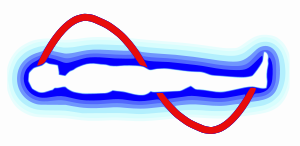About the Lectures
The effect of radiation transport and quantum noise on image quality is explored in the context of both conventional and newly developed systems. Radiation sources for imaging, mathematical descriptions of image quality, and the performance of humans as visual observers are covered. Specific systems considered include phosphor screen and direct digital radiography systems, Anger camera systems, x-ray computed tomography (CT) systems, and Positron Emission Tomography (PET) systems. Particular emphasis is given to the statistical processes important in radiographic and nuclear medicine imaging systems.
Lecture 1 : slides(pdf,4.6MB) , printview(pdf,2.1MB): Introduction
Lecture 2: slides(pdf,1.5MB) , printview(pdf,1.0MB): Radiation Physics
Lecture 3: slides(pdf,3.2MB) , printview(pdf,1.8MB): Radiation Sources and X rays
Lecture 4: slides(pdf,1.6MB) , printview(pdf,1.1MB): Radiation Sources and Gamma Rays
Lecture 5: slides(pdf,3.3MB) , printview(pdf,1.8MB): Radiographic image formation
Lecture 6:slides(pdf,3.4MB) , printview(pdf,1.8MB): Radioisotope image formation
Lecture 7:slides(pdf,3.3MB) , printview(pdf,1.8MB): Metrics of Image quality
Lecture 8:slides(pdf,2.4MB) , printview(pdf,1.2MB): Radiation Detection
Lecture 9: slides(pdf,6.1MB) , printview(pdf,3.1MB): Nuclear Medicine Detectors
Lecture 10: slides(pdf,5.0MB) , printview(pdf,3.4MB): Xray imaging Detectors
Lecture 11: slides(pdf,7.4MB) , printview(pdf,3.6MB): Computed Tomography
Lecture 12: slides(pdf,8.0MB) , printview(pdf,3.3MB): Image Display
Lecture 13: slides(pdf,4.0MB) , printview(pdf,1.6MB): Observer Performance
Computed Radiography Technology – Download
Digital Radiography
- Digital Radiography technology- Download
- Image Presentation and Display- Download
- Principles of Cathode ray tube and Liquid crystal devices – Download
- Processing Digital Radiographs – Download
- Visual Requirement for high fidelity display – Download


